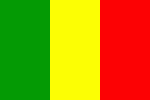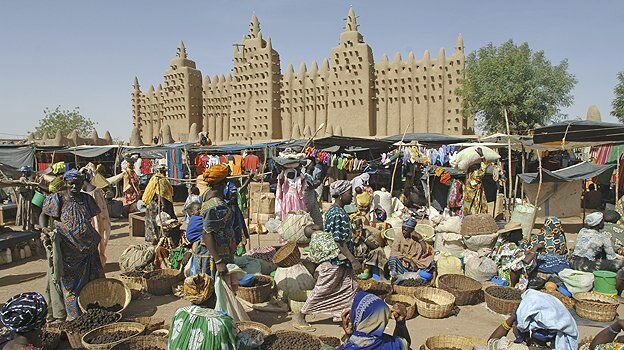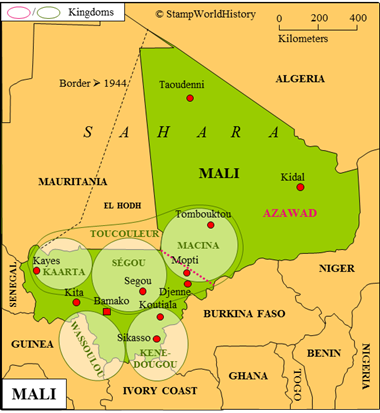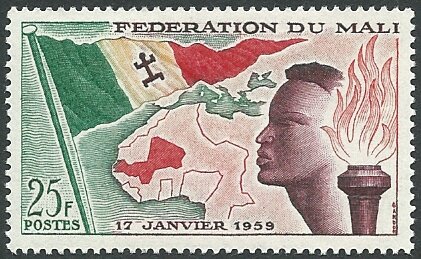
Mali
Quick reference
General issues: Federation, self government 1959-1960, Republic 1960-Present
Country name on general issues: Mali
Currency: 1 (CFA) Franc = 100 Centimes 1959-1967, 1 (Mali) Franc = 100 Centimes 1967-1984, 1 (CFA) Franc = 100 Centimes 1984-Present
Population: 3 957 000 in 1959, 15 300 000 in 2013
Political history Mali
Mali is located in western Africa. The republic of Mali, as we know it now, has a rather complex history. From the mid 19th century, Mali is divided between a number of indigenous kingdoms: Kaarta, Macina and Segou that will be united in the Toucouleur kingdom, Kenedougou and the Wassoulou kingdom. Also, in the mid 19th century, the French have established themselves in western Africa on a number of locations in the coastal regions – the main French possession being the French colony of Senegal. From the settlements in the coastal regions, the French, in the second part of the 19th century, move further inland. The main thrust into the future Mali comes out of Senegal from 1878. The indigenous kingdoms are conquered and dissolved in the 1890’s – the colonization of the future Mali will be completed around 1905.
The future Mali will go through a number of administrative changes as the French administration of French West Africa is frequently changed – French West Africa is the federation of French possessions in western Africa that was formed in 1895. Thus Mali, between 1892 and 1920, will successively be part of French Sudan, Upper Senegal & Middle Niger, Senegambia & Niger and Upper Senegal & Niger. In 1920, French Sudan is reestablished as a separate colony – now with borders that are largely the borders of the current Mali. The last major change will be in 1944 when the El Hodh region is transferred from French Sudan to Mauritania.

Market in front of the Great Mosque in Djenne – the largest mud structure in the world
French Sudan, in 1946, becomes a French overseas territory and, in 1958, gains self government. In 1959, with Senegal, the federation of Mali is formed, which gains full independence in 1960. The federation with Senegal is dissolved in 1960, upon which the republic of Mali is established as we know it today. After independence, Mali will long be governed with a one party political system – the first multi party elections are held in 1992.
The major part of the population lives in southern Mali – the largest population group being the Bambara, one of the Niger-Congo peoples, and the inhabitants of the former kingdoms of Kaarta and Segou. The scarcely populated northern part of Mali is the home of the Tuareg, one of the Afro-Asiatic peoples. In 2012, the Tuareg revolt against the central government in the capital of Bamako and proclaim the independent state of Azawad. When the revolt escalates to include extremist Islamic factions, the French intervene to reestablish control in the country. United Nations forces are subsequently stationed in Mali and are active to this day.
The Mali economy is largely dependent on agriculture – cotton being the most important product.
Postal history Mali
The first post offices in what is to become Mali are set up from Senegal in 1890. The first stamps used are the general issues for the French colonies and the stamps from Senegal. The Senegal post offices are transferred to French Sudan in 1892. From then on, the stamps of the successive political entities of which the future Mali is part will be used: French Sudan, Senegambia & Niger, Upper Senegal & Niger, again French Sudan and, from 1944, the issues of French West Africa. The first stamps in the name of Mali are issued by the federation of Mali in 1959 – the first issue commemorating the founding of the federation. The republic of Mali will issue stamps from December 1960.
Album pages
← Previous page: MalawiNext page: Mauritania →



